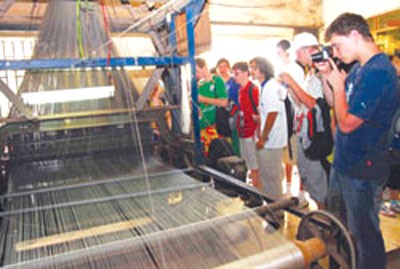(VOVworld) – A decline in sales and large inventories has been ubiquitious in many craft villages around the country. The main reason is a shrinking export market caused by the global economic slowdown. Securing new outlets and increasing cooperation among craft households are two ways craft villages are trying to cope with foreign products. VOV’s To Tuan reports….
 |
| A day to remember: Tourists visit the silk village of Van Phuc in Ha Noi. (Photo: vietnamnet.vn) |
Vietnam now has 4,500 traditional craft and trade villages. More than a third of them have been officially recognized and thousands of craftsmen have been named superior artisans. The villages employ about 12 million workers and generate extra jobs for millions of farmers during post-harvest time. Over the past decade, the villages’ average annual export revenue has exceeded 1 billion USD, but in two recent years, production in craft villages has faced numerous difficulties as a result of the global economic downturn. Nguyen Thuy Duong, a small trader in Giang Cao pottery village, Bat Trang district, says ‘In the past, our products were exported to virtually every country in the world. In recent years, due to a drop in foreign orders, villagers have turned to making items for the domestic market.’
Duong’s family, who used to produce only traditional products including geomancy pottery items, has now diversified its product line.
Craft households have started coordinating with each other to develop new designs and patterns to stimulate domestic sales. This trend parallels the government’s campaign to encourage Vietnamese to buy made-in-Vietnam goods. Craft villages have also increased their investment in pattern design and technology to improve their product quality and competitiveness. Luu Duy Dan, Chairman of the Vietnam Association of Craft Villages, has put forth some suggestions ‘Vietnam’s international integration has required traditional products to become more sophisticated and craft households to improve their production technology and their knowledge of output markets and management. The craft economy is facing a mountain of problems in credit shortages, shrinking markets, outdated technology, untrained workers, environmental pollution, and shortages of land for production. So along with government support, craft villages and households need to look to each other for support.’
Vietnam has, this year, earned more than 1.1 billion USD from exporting handicrafts and fine arts articles, and expects to reach 1.6 billion USD for the whole year. Under the country’s orientation for craft villages by 2020, sustainable growth of traditional craft and trade villages will be linked to tourism development and environmental protection.
To Tuan